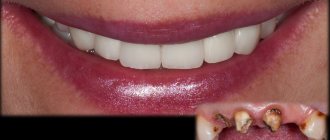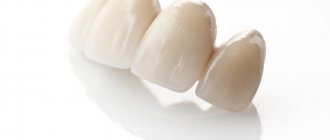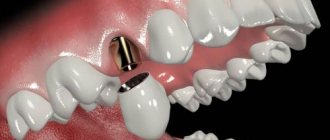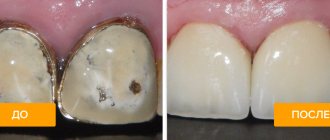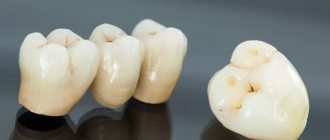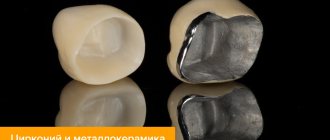At their core, crowns are dentures made in such a way that they are almost impossible to distinguish from real teeth. With the help of crowns, both one tooth and several nearby missing ones are restored.
The search for the optimal material for making dentures has led to the fact that dentists now offer a large number of them to choose from. But how can the average person navigate this diversity and choose the best dental crown? Specialists at the AcademyDENT clinic will try to answer this question. On our website you can see in the photo what a crown on a tooth made of different materials looks like.
When are dental crowns needed?
Dentists have identified the following indications for the installation of this type of prosthesis:
- Destruction of the crown part of the tooth by more than 50%. Most often, this situation occurs with severe caries or with injuries. In this case, a crown is installed to protect the tooth from further destruction.
- Protection of pulpless teeth. Removing a nerve from a dental canal is accompanied by a weakening of the enamel - it becomes fragile, so it is quite advisable to protect it with a crown.
- Any aesthetic defects: tetracycline teeth, fluorosis.
By contacting the AcademyDENT clinic, you are guaranteed to receive a qualified consultation with a doctor who will tell you exactly whether you need a dental crown or whether other treatment methods are possible.
The indications for the use of these structures are the broadest:
Indications for the use of crowns
- Defects of the natural crown are more than half its size;
- Increased (inappropriate for age) abrasion of teeth; correction of jaw relationship (bite);
- Deep wedge-shaped defects are areas of triangular-shaped loss of hard tissue in the neck of the tooth (near the gums), weakening it and increasing the risk of complete breakage during chewing;
- Congenital anomaly of tooth shape (for example, underdevelopment or complete absence of enamel) or acquired (for example, after injury);
- Some congenital or acquired pronounced color changes that cannot be eliminated by bleaching (discolorities) are the consequences of injuries, medications used or materials for filling root canals;
- Tilting and/or protrusion of a tooth or a group of them when the patient refuses orthodontic treatment (orthopedic “movement”);
- Combining - splinting - teeth when they are mobile (the crowns are not made separately, but as a single block and are fixed at the same time);
- The need to improve the shape and protection of the tooth during removable prosthetics (creating pronounced convex contours that will hold the fixing elements and, along with them, the prosthesis itself);
- The presence of aesthetically unsatisfactory crowns (all-metal, combined with chips of the facing material or a gray-blue border, visible at the gingival margin when it decreases or thins).
Despite the variety of clinical situations in which the use of these structures is justified, the general rule is prosthetics in the early stages.
Contraindications
It is not possible to install a crown on every tooth - there are certain situations when the feasibility of its installation is highly questionable. Contraindications include:
- pathological tooth mobility;
- insufficient height of the tooth crown - in this case the prosthesis will sink;
- chronic inflammatory processes in the mouth;
- unfilled canals of the prosthetic tooth.
At AcademyDENT, doctors carefully follow all indications and contraindications for prosthetics, so we have an extremely low percentage of complications.
Ceramic crown
Ceramics is the most suitable substance for making teeth, since in its composition and structure it is very close to tooth enamel. Ceramic crowns are an ideal option for prosthetic restoration of anterior teeth, as they provide the most effective aesthetic replacement.
So the advantages:
- excellent aesthetic effect;
- excellent prosthetics for both frontal and chewing teeth;
- resistant to dyes.
E-max glass-ceramic crown prostheses are becoming increasingly popular.
Metal crown
Dentures began to be made from metal almost 100 years ago. Initially, preference was given to gold - crowns were made from it quite simply, but were too soft. Gradually, a special gold-based alloy began to be used for crowns - the addition of other metals makes it possible to achieve high strength of the product.
Nowadays, dentists use not only precious metals (gold and silver) to make crowns, but also “base” metals: titanium and steel. All metal crowns have a rather low aesthetic quality - the presence of gold teeth in the mouth currently does not make a person beautiful. In addition, the cost of such products is actually not considered one of the lowest.
Metal-ceramic crown
In search of a compromise between the unaesthetic appearance of metal and the insufficient strength of ceramics, dentists developed metal-ceramic dental crowns. During their manufacture, a ceramic coating is applied to a metal base, masking the metal, while the metal base provides sufficient strength and rigidity. The advantages of such structures include:
- reasonable cost;
- natural appearance;
- strength comparable to conventional metal prostheses.
Disadvantage: when the gum recedes, the metal part of the crown appears from under it, which reduces its aesthetic value.
Aesthetic properties of metal ceramics
Metal-ceramic crowns have excellent aesthetic qualities. Modern technologies make it possible to achieve any shade of ceramic coating color.
In the 60s and 70s, there was a fashion for the so-called “Hollywood smile”, to create which metal-ceramic dentures with straight white teeth were made. Despite its external attractiveness, the “Hollywood smile” is unnatural, lifeless and, with rare exceptions, does not match the remaining teeth.
Increasingly, patients began to express wishes that artificial teeth would not differ from the preserved natural ones. But the possibilities of materials for the manufacture of metal-ceramic dentures were then very limited.
This led to the emergence of a number of research projects aimed at developing dyes, effect masses, opalescent porcelains, etc. A revolutionary step in the development of materials for creating natural aesthetics in dentures was the creation of the internal coloring technique, developed by one of the world's most famous dental technicians, Hitoshi Aoshima. The principle of this technique is that all the characteristic features of the tooth are not drawn with dyes on the surface of the metal-ceramic prosthesis, but are modeled from the inside.
Luster (glossy) porcelain was also developed. Research scientists have come to the conclusion that tooth enamel, in its shine, resembles the surface of a pearl. To imitate the natural shine of enamel, scientists have created a new technology for producing opalescent materials. The surface of luster porcelain, thanks to the ultra-fine structure of the particles, resembles the enamel of a natural tooth in its relief, ability to transmit light and color.
If the metal ceramics nevertheless turn black, then the reason for this may be trivial - the patient forgets to brush his teeth. If the lowest layer of ceramic, opaque, does not sufficiently dampen the metal frame and allow chromium ions to pass through (in the case of a cobalt-chromium alloy), then they give the accumulated plaque an unpleasant greenish tint. Individual oral hygiene is very important for everyone, and especially for those who have metal-ceramic dentures.
Metal composite crowns
Another attempt to combine metals and non-metals in dental crowns is metal composite crowns. Their peculiarity lies in the manufacturing method - a light-curing composite is applied to a metal base. A new tooth is formed, similar to a real one. Such dental crowns are very attractive from an aesthetic point of view; they look very good both in place of the front teeth and in the place of chewing teeth.
But there are more disadvantages than advantages.
Plastic dental crowns
Dental crowns made from plastic are the cheapest option of all types of dental crowns. They are made the fastest and easiest, the cost of material for them is the lowest. Most often, temporary crowns are made from plastic and placed on patients while permanent crowns are made from a different material.
Pros:
- fast production;
- ease of installation;
- cheapness.
Flaws:
- wear out quickly - service life does not exceed 2 years;
- low strength - it is not recommended to install them on chewing teeth;
- low aesthetic value.
The main stages of installing a crown on a tooth
The process of prosthetics of the crown part of the tooth occurs in several stages:
- Diagnostics - a preliminary assessment of the condition of all teeth in the oral cavity is performed. To do this, a thorough dental examination is carried out, during which the amount of treatment required is assessed.
- Treatment - all carious teeth are treated, if necessary, depulpation of the target tooth is carried out with filling of the canals.
- Tooth grinding - tools are used to model the tooth for a crown. If the dental tissue is preserved in sufficient volume. then a simple grinding is performed, but if the tooth is too damaged, then a special inlay is installed.
- Taking impressions - these are necessary to make an anatomically compatible crown shape.
- Making crowns - this process takes place in a dental laboratory, where a tooth model is made based on impressions, and a crown is made on its basis.
- Installation of crowns - they are fixed to the prepared tooth with special dental cements or composites that provide reliable fastening.
At DENT Academy, each of the above stages is carried out in strict compliance with international standards, which completely eliminates errors and inaccuracies during the process.
A laboratory technician performs the following manipulations:
Making diagnostic models of jaws
- Making diagnostic models of jaws;
- Making temporary crowns (if they are not made directly by a doctor in the office using a silicone key - a special material is applied to the area of interest and retains its shape when hardened); as a rule, the help of a technician is required in case of severe initial destruction - in this case, he casts a model using an impression, models the damaged areas on it with wax, and from this structure, using a key, makes temporary restorations;
- Making working models from supergypsum based on final impressions;
- Making a wax reproduction of the final restoration followed by a step-by-step replacement of materials (for example, casting a base for a combined structure, followed by application and firing of ceramic mass).
In addition to the traditional manufacturing method, there is also the so-called milling from ready-made blocks on a computer-controlled machine (CAD/CAM technology, for example CEREC, EVEREST). Using an optical system, an impression is taken (essentially scanned) either of the prepared area directly in the oral cavity, or of a model, then the data is transferred to a computer, where the image is processed by a special program, a model of the future restoration is built, which can be corrected, and then sharpened and finalized ( painted and glazed to give a shine comparable to natural). Now this is the most accurate way to create structures of various sizes and lengths (up to the entire dental arch), because human involvement and therefore possible inaccuracies are reduced to a minimum. The next step will obviously be the development of 3D printing technologies.
What determines the cost of a dental crown?
The final cost of prosthetics is influenced by several important factors:
Pricing policy for a specific dentistry: All private clinics target a specific cohort of consumers with approximately the same level of income. Therefore, the cost of the same prosthesis can vary dramatically. DENT Academy does not offer the lowest prices - we offer very high-quality work at an adequate cost.
Cost of materials: It is logical that plastic dentures are much cheaper than zirconium dioxide, so when choosing a specific type of dental crown, you should focus on your financial capabilities. Our clinic specialists will help you choose the best option that combines high quality with an affordable price.
The clinic has its own dental laboratory: The technological process of making dentures is financially very expensive. If there is no laboratory, the clinic is forced to enter into an agreement with an independent laboratory. Naturally, the cost of such prostheses will increase, if only because of logistics costs.
Qualification of personnel: it is natural that when a doctor with extensive experience and work experience receives more money for it, accordingly, the cost of his work will be higher than that of a young specialist who has no experience and whose quality of work is unknown. The price of dentures also includes the cost of paying for the work of a dental technician, whose qualifications largely determine the quality of the manufactured crown, especially when it comes to high-tech structures.
Technological aspects of metal ceramics
In the process of manufacturing metal-ceramic structures, there are a number of key points that deserve special attention.
Tooth preparation for metal ceramics.
- The tooth must be prepared (ground) with a ledge at the gum level.
- The total thickness of the metal frame and the ceramic mass covering it is about 1.5 mm. As a result, if the tooth is ground without a ledge, we get the edge of the crown hanging over the gum and pressing on it. The crown presses against the blood vessels and a “bruise” forms. The metal frame comes into direct contact with the gum, and metal ions cause it to darken.
- In the case of preparation with a shoulder, the edge of the metal-ceramic crown rests on the hard tissues of the tooth without injuring the mucous membrane. This technology is quite labor-intensive, and its implementation requires a modern dental unit and, of course, the qualifications of a doctor and dental technician.
The intermediate part of the metal-ceramic bridge prosthesis should also not put pressure on the mucous membrane (gum), otherwise bedsores may form. Of course, in those places where it is visible, you have to make a compromise, but in any case the touch should be very gentle. And if food gets into a place where there is a loose seal, it will be much easier to remove it from there than in the case of the “full contact” option.
Many doctors “sin” by depulping (removing the nerve of the tooth) even healthy teeth under metal-ceramics, which is not always justified, since modern technologies make it possible in many cases to avoid this procedure. Depulped (dead) teeth cannot resist infection and often have to be re-treated. In addition, a pulpless tooth becomes more fragile and can collapse under a heavy metal-ceramic structure.
How and why dental crowns are removed
A well-made dental crown can be worn for decades, of course, if the material from which it is made is designed for this. However, standard recommendations are to replace it every 10 years or more frequently as required.
Premature removal is carried out when certain unpleasant symptoms appear, most often indicating incorrect installation. So, crown removal is carried out when the following symptoms appear:
Crown pain
Although modern techniques for working with materials make it possible to ensure a filigree match of the crown to the prepared tooth, sometimes situations arise that the patient complains of pain in the crown. Of course, it is not the tooth that hurts, but the tooth on which it is installed. Among the causes of pain, caries is the leading cause; less often, pain occurs with untreated roots.
Unpleasant smell
The appearance of a putrid odor may be due to the fact that food particles are packed under the crown. Due to the inability to remove them even with the help of high-quality teeth cleaning, they become contaminated with bacteria and decompose, which is accompanied by a putrid odor.
Care instructions
Everyone knows that proper daily dental care is the basis of health. However, after installing porcelain products, you need to take more careful care of your oral cavity. To increase the service life of crowns, you need to follow some recommendations:
- Do not place excessive pressure on the prosthesis.
- If possible, avoid eating solid and tough foods.
- Providing quality oral care - brushing your teeth 2 times a day, rinsing your mouth after snacks with still water or mouthwash, and cleaning in between with dental floss.
- All hygiene products must be selected by a doctor.
- Carry out dental cleanings annually.
- Visit a specialist twice a year for a preventive examination.
Today, porcelain crowns are the most popular prosthetic products, despite their high price. Most people prefer not to save on their teeth, installing structures made from quality materials. With proper care and following the advice of specialists, dentures will serve their owners for a very long time.
